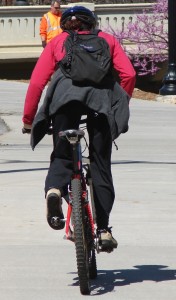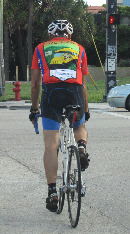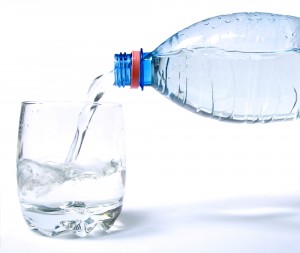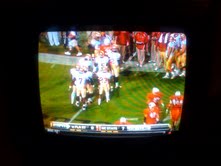Archive for the ‘Sports’ Category
You don’t have to be a hard-core athlete to appreciate endurance. Sometimes we want to push ourselves physically, for all sorts of reasons. Walking 18 holes. Winning the football game. Playing doubles. Running that annual 5K. A long bike ride on Saturday.
 So it’s “competition” day . . . now what? You may have trained and trained, but have you consistently fueled your body with the right substances (foods and fluids)? It really matters what fuel you choose; why wouldn’t it? And the body’s energy is finite: if it’s not resupplied, it will run out. Push it hard, it runs out faster. Fuel incorrectly, and all your training will be for naught. What a pity.
So it’s “competition” day . . . now what? You may have trained and trained, but have you consistently fueled your body with the right substances (foods and fluids)? It really matters what fuel you choose; why wouldn’t it? And the body’s energy is finite: if it’s not resupplied, it will run out. Push it hard, it runs out faster. Fuel incorrectly, and all your training will be for naught. What a pity.
Here are some Keys to give you a competitive edge. They will unlock a new level of physical success for you, in whatever arena you need it.
Key #1. Plan, plan, plan. You already know you need to prepare physically for an event. But even more key is planning ahead nutritionally. Take time to learn how starches, carbs, protein and hydration fuel the body for highly physical endeavors, and how they’re also used to help it recover quickly, building lean muscle tissue as a result. I’ve given you some great starter tips below.
Key #2. Practice, practice, practice . . . but I don’t mean training! Literally practice your “competition day” eating before that important event. A coach once told me ‘ if you put the maximum effort into your practice, you will have the maximum benefit during your game days.’ Now I tell all my athletes that same thing.
Key #3. Fuel properly the night before. The big pre-competition “no-no’s” are 1) anything with a lot of sugar; 2) fried or spicy foods; 3) high fat foods: gravies, sauces, creamy soups, fatty meats. And DON’T try any foods you’ve never eaten before.
Key #4. Same no-no’s apply on game day. Eat starches approximately 3-4 hours prior to your event, and make the portions slightly smaller than normal meal. They give you “timed-release” energy. About 30-60 minutes before starting the event, top off your tank with fluids and a small snack (a piece of fruit or granola bar).
Key #5. During your competition (or on tournament days with multiple events or games) make sure you’re drinking at least 8-12 ounces of fluids between each game or event. Eat a healthy snack – such as yogurt, a sports bar or trail mix – between each game and event. If you’re exercising for longer than an hour without taking a long break, you need to keep refueling during the event, with foods like pretzels, fruit, granola or fruit snacks. Remember: drink plenty of fluids!
Key #6. When in doubt DON’T go without! Some people find that liquids are easier on their stomachs while they exercise. But what’s in the liquid is critical. Don’t go without proteins or nutrients; try chocolate milk, smoothies, or meal replacement shakes.
Got it? Plan ahead, practice, hydrate and don’t go without fuel.
I’ve long been a proponent of giving yourself a little food or beverage treat now and then. It’s the perfect way to reward yourself for a full week of eating healthy and respecting your body.
I got a kick out of hearing ESPN report tonight (during a game) that the Florida State Seminole football team gets a “cheat day” on Mondays. The team nutritionist apparently lets them relax their nutritional standards one day a week, to keep them on course.
The reporter also added that “if the team wins, they get to choose their meal, and their favorite is honey-fried chicken.”
Obviously a southern team ! LOL
I’ve worked with several teams and always look forward to helping them achieve their goals. My 80/20 rule says that 80% of effective athletic training is nutrition: the fuel you put in the body.
If any Noles find this blog, congrats on having an impressive 2010 football season with your new coach!
Exercise requires energy, pure and simple. But where does it come from? The answer is glycogen. But what is it?
 When we digest food we’ve eaten, the carbohydrates are broken down by our bodies into glucose, and then the glucose is stored in our muscles . . . as glycogen. During periods of exercise, this process reverses, and glycogen converts to glucose once again, so that is may be used for energy. How long we “last” is greatly influenced by how much glycogen we have stored in our muscles.
When we digest food we’ve eaten, the carbohydrates are broken down by our bodies into glucose, and then the glucose is stored in our muscles . . . as glycogen. During periods of exercise, this process reverses, and glycogen converts to glucose once again, so that is may be used for energy. How long we “last” is greatly influenced by how much glycogen we have stored in our muscles.
Exercise that lasts less than 90 minutes is typical for most of us. Carbs typically provide 40-50% of our energy in the beginning stages of moderate exercise. What the body naturally stores will sustain you through a workout of this length.
But as the intensity of physical activity increases, the body’s carbohydrate consumption increases too. For events over 90 minutes, eat a heavy-carb diet for 2-3 days prior.
Picture the muscles like porous rocks. The more glycogen is filling all those crevices, the more energy reserves we have to draw upon. This is why cyclists, marathoners, triathletes, soccer players and other endurance athletes excel when they’ve pre-loaded for 2-3 days with about 70% carbs. Glycogen is the fuel which sustains the body in highly physical situations.
Have you heard the term “hitting the wall?” This refers to an actual event in the body, the depletion of glycogen. Once stores are gone, energy is truly kaput; you have no way to generate more.
Don’t assume you should eat a high-carb diet all the time, though, even if you exercise heavily. Once glycogen fills all the areas where reserves can be stored, any extra that is produced is stored as body fat. Eating too many carbs causes this excessive glycogen production.
Another danger of overdoing carb consumption: you can unwittingly “train” your body not to utilize essential fatty acids that come from fat. Not only does fat transport cholesterol and play a role in blood clotting, it helps us absorb vitamins and produce hormones.
Conversely, eating too few carbs forces the body to use protein for energy. The body will actually start to break down protein – the building blocks for muscles, bone, and other tissues – meaning you put yourself into a sort of self-cannibalization. Your body starts to feed on its own muscles and you lose muscle mass. This is also tough on kidneys. Not a pretty thought.
So strike a happy balance between protein, carbs and fat, and remember lean protein, high fiber and unsaturated fats as your first choice. It’s all about balance and timing: my 80/20 rule. Athletic training is 80% nutrition, 20% training. Get the food right, you have a bonafide mega-advantage over the competition.
Michelle Ciuffetelli, a Certified Personal Trainer in Fort Myers, Florida, says her favorite carbs are oatmeal (filling and a good source of fiber); sweet potatoes; fruit (a great snack); Arnold Sandwich Thins (good fiber); and Flat Out wraps (taste great, can wrap anything).
Now get moving. That’s a wrap!
 What cyclists eat and drink determines how fast and how far they can ride. What are your goals? Recreation, competitive racing, or heavy-duty triathlons? Even recreational riders should pay attention to their diet; maximize your ride and get the body you want. All athletes and exercisers need energy to function.
What cyclists eat and drink determines how fast and how far they can ride. What are your goals? Recreation, competitive racing, or heavy-duty triathlons? Even recreational riders should pay attention to their diet; maximize your ride and get the body you want. All athletes and exercisers need energy to function.
Many cyclists avoid caffeine, knowing it’s a diuretic, but here’s a surprise. During endurance exercise, the dehydrating qualities of caffeine are practically nil with small amounts of caffeine. And studies have shown that it may help the body burn fat, rather than carbohydrate reserves.
Coffee is not an ideal source of caffeine for exercisers or athletes – therefore, don’t think you can justify your Starbucks habit. We have only 1,500-3,000 calories of reserve carbs, but the body stores 70,000 fat calories at any given time, so burn, baby, burn.
Each hour of an intense bike ride will use 500-1,000 calories. Your overall protein needs will increase during exercise; supplement at 1.2-2. g protein per kilogram of body weight per day depending on your intensity and length of exercise.
For endurance events, you can increase your carbs three days prior. This maximizes the body’s glycogen stores. While you ride, you need 30-60 g of carbs for each hour beyond the first hour. An energy bar works.
Practice eating while you ride and don’t change your food choice on race day. Remember, fat can contribute as much as 75 percent of your energy demands during endurance training. Keep foods simple.
During a ride in hot weather, the body’s ability to digest becomes compromised. Liquid foods avoid this situation, and keep you speeding along without much hassle. Certain energy drinks can fill the bill, as does an Ensure protein drink, available in any drug store.
Ensure also comes in powder form; having baggies of it allows you to add it to water, drink a meal, and continue on. You can also mix fruit juice and water for a source of hydration, carbs and sugar for your blood.
How’d you like to burn 350-500 calories per hour, doing something that’s refreshing and widely available? If your answer’s yes, then go put on your swimsuit and keep reading. Swimming is great exercise, whether you do it casually or in a serious, “endurance sport” manner.
 Triathletes must make diet their primary focus if they want to significantly improve their performance. But for any type of athletic conditioning, nutrition is at least 80 percent of the formula, and training makes up no more than 20 percent.
Triathletes must make diet their primary focus if they want to significantly improve their performance. But for any type of athletic conditioning, nutrition is at least 80 percent of the formula, and training makes up no more than 20 percent.
Keys to the 80/20 formula are quality, quantity, and timing of nutrients … learning not only what to eat but also “how and when” will maximize results in triathlons, multiple-sport activities, and even for recreational exercisers. Developing good eating habits every day can make the difference between great training/exercise/events, and just struggling through.
Note that I said “habits.” Eating well can become a habit over time, one you no longer have to think about, or feel burdened by in any way. Commit to the concept of positive, life-enhancing, sport-enhancing long-term change through diet, and over time, you will develop this good habit just as easily as people develop bad ones.
Now, back to the pool. Is there any truth to the phrase “no swimming until one hour after you’ve eaten?” Yes, a bit, but only if you’re planning on swimming with extreme intensity, as in a triathlon.
Recreational swimming falls in a different category. You, your children or grandchildren can all swim or play in the pool after eating. Frolicking with a full belly is perfectly safe.
In fact, if you plan to swim in the morning – especially just after rising from a night’s sleep – eat something. Engaging in vigorous exercise on an empty stomach will cause you to suffer. You’ll feel weak, possibly dizzy, perhaps sick to your stomach. Certainly your workout will be a poor one and most likely will have to be cut short.
After sleep, your blood sugar is low. So have a snack before you hit the pool.
Swimming is less demanding than running or cycling for pre-activity nutrition. Even fruit, toast or a sports drink will do, to elevate the blood sugar a bit. Hydration before or during swimming is not much of an issue because you won’t overheat in water, but hydration after swimming restores electrolyte balance.
In all three triathlon sports, post-workout nutrition should occur within 30 minutes of stopping, when the body is most receptive to carbs for replacing glycogen lost during the workout. Ingesting protein will help muscles recover and rebuild stronger.
Women swimmers especially need to be aware of the potential for iron and/or calcium deficiencies. Lacking either or both of these essential minerals will affect performance.
Remember the 80/20 rule and decide now to develop good habits. It does not matter how hard or how much you exercise; good nutrition and healthy eating habits are the crucial component. Next week we’ll discuss nutrition for cycling.
Whether you’re a triathlete, a recreational or endurance runner, or even a power walker, your body relies on proper fuel to do what you ask it to do. Training will take you only so far, no matter how religiously you do it. Here’s a surprising statistic I mentioned last week: nutrition counts for 80 percent of athletic training.
 A total of 45-65 percent of runners’ and walkers’ diets should be carbohydrate-rich foods. Carbs give us quick and long-lasting energy. They’re also easier for the body to use than proteins or fats.
A total of 45-65 percent of runners’ and walkers’ diets should be carbohydrate-rich foods. Carbs give us quick and long-lasting energy. They’re also easier for the body to use than proteins or fats.
I’ve always been an advocate of eating whole-grain foods – breads and pastas, wild rice, veggies, beans and oatmeal – but you must read labels carefully. Whole wheat does not equal whole grain.
Runners also need “good” fats, typically 20-30 percent of daily intake. Fat is energy for muscles, once quick-burning carbs have been used. Avoid trans fats. Heart-healthy omega-3s come in walnuts, flax seeds, cold-water fatty fish, soybean and canola oils and even tofu.
Don’t forget protein. A total of 15-35 percent of a runner’s diet should be lean proteins such as fish, poultry, low-fat dairy, nuts and seeds. Avoid foods high in saturated fats and cholesterol.
Find the percentages that work for you, and remember: hydration is key to the formula, and timing is everything. Drink early: do NOT wait for thirst to set in. Think of hydration as a pro-active commitment, not as a fix for thirst. Watch your urine: if it’s pale, you’re drinking enough water.
Always choose a pre-exercise meal that’s low in fat and fiber, is high carbohydrate and includes moderate protein. That’s the formula for endurance and energy.
While running, consume approximately 8 ounces of water every 15 minutes. If you’re exercising longer than an hour, alternate water and Gatorade about every 15-20 minutes. For high intensity workouts, I also suggest a sports drink like G2 (Gatorade2).
After running, you need 3 cups of fluid for every pound lost. Your body also needs protein and carbs (like chocolate milk and trail mix). A protein boost within 15-20 minutes of ending your workout will dramatically affect how your muscles rebuild and replenish.
The time period right after exercise – your short-term “recovery” window – is the most critical for improving your body. Training breaks down muscles, literally, and depletes natural energy stores (glycogen). During recovery, muscle tissue begins to repair and in so doing, strengthens. Energy replenishes.
Timing is key. Your short-term recovery window is only about 45 minutes, and can be wasted during a post-workout chat and/or drive home. Once this window closes, your muscles will no longer be receptive to the nutritional assistance you could have provided.
Bottom line: have a snack immediately following a workout that contains carbohydrate and protein, for this critical period. You’ll start to see a real change in your muscle tone, endurance and energy.
A good post-exercise meal, within 60-90 minutes, could be salmon, brown rice, broccoli, peppers and carrots. Let your body enjoy long-term recovery on “no-workout” days, while you focus on a healthy diet. And don’t skip meals. I personally eat six small meals a day.
Next week: nutrition for swimmers.
Intro to 3-Part Series: Nutrition for Running, Cycling, Swimming
Over the next four weeks, I’m going to talk about proper nutrition for a variety of sports: running, swimming and cycling. Many Floridians participate in one or more of these physically demanding (but fun) outdoor activities. A few combine them for triathlons – my cap’s off to you.
And here’s the thing. The human body can excel at a demanding sport only when fueled correctly. This may shock you, but proper nutrition is at least 80 percent of the formula for successful exercise and athletic training.
Don’t be misled by my use of the word “training.” If you’re a soccer mom taking a lot of classes to keep your tush looking toned, you are training. Dads who cycle five nights a week to keep the effects of aging at bay are training. And, of course, if you’re an individual or team athlete striving for wins, records, medals or the like, you know I’m speaking to you.
But you can train seven days a week – devoting hours and hours of your life to your pursuit – and without giving your body what it needs to support and achieve those goals, you will not end up where you want to be, including in the weight department. You may not even come close.
Picture Kyle Busch on the track in Indianapolis, and his car without the right kind of gas and fluids. Nothing in his driving skills can overcome the fact that his vehicle is not fueled for the task, and your body is no different.
Sports nutrition has many components. Sure, it’s important what foods you include in your daily diet, be they carbs, protein, fats, sugar or liquids. Carbs and proteins both have specific functions. We must understand what our body needs, how it uses what we give it and how we can maximize what it naturally provides. This is how we learn to boost our energy reserves so we can train harder, build lean muscle and avoid storing fat.
As important as what an active adult eats is the timing of when it’s eaten. I’ll talk about how and why to “pre-load” for a workout, and how nutrition can speed up post-activity recovery. Much of our body’s healing from exercise takes place while we sleep, so nutrition for proper sleep is also critical.
Next week, we’ll start with nutrition for running. (If you spend time on the treadmill in your gym, this will apply to you.) All my running readers will gain a real footing on the road to success. It starts with nutrition.
Ever heard the term “Weekend Warriors?” These fun-loving, sports-minded folks work hard then occasionally decide to have some fun by participating in an activity that’s new (or old and dear). The problem is, their body isn’t conditioned through diet and exercise for what’s about to happen, and the result is often an injury … sometimes a bad injury.
Common catalysts for weekend warrior syndrome are spring thaw, reunions, holidays, turning 40, turning 50, New Year’s resolutions and your teen’s friends playing ball in the lot next door. There are abundant opportunities to “jump right in” and although your heart’s in the right place, you could pay a big price later.
I’ve fallen victim to this scenario myself. I work out on a regular basis and eat well, but recently I played a charity softball game, a sport that I used to play in my younger years … and I could not get out of bed on Monday. I also could not use my Blackberry because my hands hurt so bad.
Had I at least been doing some type of similar activity before that game, or stretching the body parts I knew I’d be using, I might have had a fighting chance. Changing from a flat gym floor to uneven earth or rolling trails or sloped beaches can also cause issues. Imagine what the 50th-birthday-but-20-mile-bike-ride might do to an office worker.
If we’re not used to using certain muscles, we make ourselves prime candidates for debilitating or highly irritating injuries. I was thinking about the various ways to keep the body prepared for the occasional odd activity, and came across a great quote on the Internet: “Men over 40 should be fit for their sport rather than using their sport to get fit,” it said. This surely applies to everyone contemplating a sudden, big burst of athleticism.
The easiest way to avoid injury is the one requiring the most discipline: don’t do too much of anything that’s new. Start out in moderation, play part of the game, do 5 miles instead of 20. You could save yourself a stress fracture or a couple of very uncomfortable weeks.
Flexibility and stretching are key, too, so if you know you have a new sport ahead, start working that part of the body, stretching daily, and always stretch after a workout to gain flexibility. A balanced diet and proper weight is always a good idea. Hauling an extra 30 pounds around a make-believe football field is tough.
Here’s another tip: A lack of magnesium can lead to muscle weakness and cramps. Magnesium is lost via sweat, so regular exercisers and even saunagoers need to take in enough magnesium rich foods or supplement magnesium. But after a spontaneous workout, you’d do well to have some on hand.
Weekend warriors can benefit from maintaining a healthy mineral balance. Think of magnesium as your “muscle mineral.” The FDA recommends 310-420 mg daily for most adults.
Here are a few magnesium-rich foods if, like me, you prefer a healthy diet to taking lots of supplements: 3 ounces of halibut, 90 gm; 1 ounce dry roasted almonds, 80 gm; 1 ounce dry roasted cashews, 75 gm; 1/2 cup cooked soybeans, 75 gm; 1/2 cup frozen spinach, 75 gm; 1 ounce mixed dry roasted nuts, 65 gm; 2 biscuits of Shredded Wheat cereal 55 gm; 1 cup instant fortified oatmeal, 55 gm.
I also like to keep resistance bands all around me: tied to doors, in my travel bag, in front of the TV, wrapped around the legs and arms of my chairs. A good 10-minute workout with bands can be great if done right.
So if your college roomie has challenged you to a tennis rematch from days gone by … start working the “pushing” muscles on your chest wall, and get your shoulder primed for action. Do some sideways motion drills, and start taking magnesium. If it’s been a while, you’re going to need it!
 In my last column, I explained that whey protein is often a problem for lactose-intolerant people who are using a protein supplement. It’s easy to assume that a protein supplement is beneficial for only extreme athletes such as bodybuilders, but that couldn’t be farther from the truth.
In my last column, I explained that whey protein is often a problem for lactose-intolerant people who are using a protein supplement. It’s easy to assume that a protein supplement is beneficial for only extreme athletes such as bodybuilders, but that couldn’t be farther from the truth.
Protein has many uses and supplementation is beneficial for a wide variety of users. They include the elderly; those with joint or degenerative diseases, or orthopedic conditions; the overweight; people who do heavy manual labor in their work, sport or hobby; those going through growth phases; people in physical rehab; men and women doing intensive training for a sport or competition; adults who work out on a regular basis; teen athletes who are trying to build muscle and strength; people taking symptomatic treatment for pain relief or inflammation; and anyone with pain resulting from excessive joint stress. Hardly anyone you know doesn’t fit onto that list somewhere.
The trick is getting that extra protein without absorbing a lot of extra calories, fillers or dairy products (as in the case of whey protein powder).
Collagen is a great way to get added protein. Did you know that collagen is the second-largest component of the human body after water? It’s a protein, and one found in muscles, joints, ligaments, tendons, bones and more.
Historically, physicians have used collagen to treat skin trauma, such as burns and wounds. But collagen also affects the hair, nails and overall healthy appearance of skin, which is why you see it advertised in high-end skin care products.
As we age, our bodies stop producing collagen protein, and sadly, it’s collagen that gives our skin elasticity. So the appearance of dry, wrinkled skin is really the lack of collagen. Supplementing your diet with a natural source of collagen protein doesn’t just make you more youthful looking, however. Collagen builds lean healthy muscle – the muscle of youth – as well as healthy joints and bones. Can you think of a better supplement to give the special elders in your life?
Collagen protein also helps aid in the repair of muscle tissue. Because a good workout or physical exercise is actually breaking down the body’s muscles, collagen protein assists in the rebuilding process. Collagen makes it possible to heal faster, simultaneously building leaner muscle, following a workout. Some will even find they sleep more soundly when taking collagen protein. Sounds better all the time, doesn’t it?
You may wonder why a person can’t just eat more protein and gain the same benefits. It’s about bioavailability. Protein in food form has calories, of course, and a healthy daily diet only contains so many. The bioavailability of the protein also comes into question. By the time your body works to chew and digest the food, you’re not getting nearly as much protein as the amount you started with on your plate.
A powder form can provide extra protein without as much work for the body, but comes with the added calories of what it’s poured into. A liquid protein is your best bet. Find one that’s small in calories, and better yet, hydrolyzed – or “predigested” – which simply means that you ingest it in its smallest form, with no extra work for the body to break it down.
I encourage you to join me – and my husband and my teenage son – and add a low-cal collagen protein supplement to your diet. You could be amazed at the changes you experience. See the developing abs on the teen in the photo? That’s my son Cody, who drinks a liquid collagen protein supplement and works out regularly.
- Elaine Hastings is a registered dietitian, sports nutrition authority, and and owner of Associates in Nutrition Therapy in Fort Myers, Florida. She can be contacted at Elaine@eatrightRD.com or by visiting Associatesin Nutrition.com.




Follow Us!